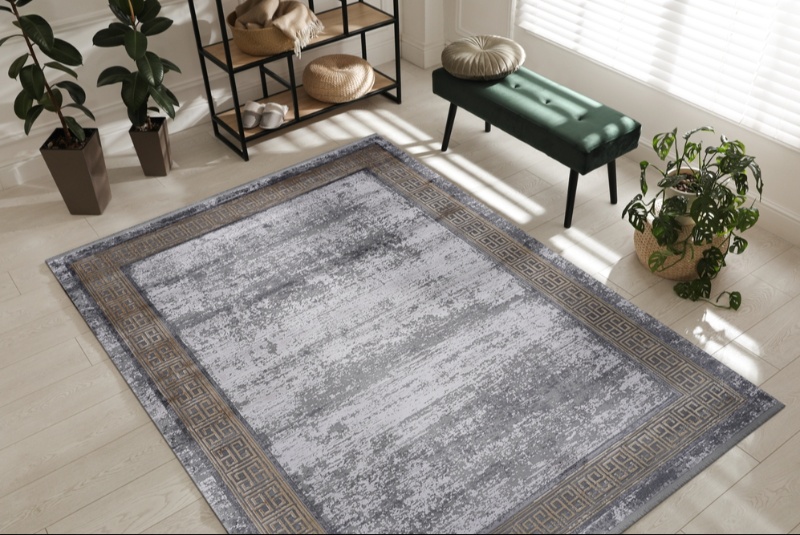A high-quality rug can transform a room, adding warmth, style, and comfort to your home. However, with so many options available, choosing the right rug can be overwhelming. This comprehensive guide provides essential tips and insights to help you select the perfect rug, ensuring it meets your aesthetic preferences, durability requirements, and comfort needs.
Understanding Rug Materials
The material of a rug significantly impacts its look, feel, and longevity. Common materials include wool, silk, cotton, synthetic fibers, and natural fibers like jute and sisal. Wool is durable, soft, and naturally stain-resistant, making it a popular choice. Silk rugs offer a luxurious feel and vibrant colors but are less durable. Cotton rugs are soft and easy to clean but may wear out faster. Synthetic fibers like nylon and polyester are affordable and durable but may lack the natural feel of wool or cotton. Understanding rug materials helps you choose one that suits your lifestyle and preferences, ensuring long-term satisfaction.
Evaluating Rug Construction
The construction of a rug affects its durability and texture. Hand-knotted rugs are high-quality and highly durable, often considered works of art due to their intricate designs and craftsmanship. Hand-tufted rugs are made using a tufting gun, resulting in a durable and less expensive option compared to hand-knotted rugs. Machine-made rugs are produced quickly and cost-effectively, offering a wide range of styles but typically lower quality. Evaluating rug construction ensures you select a rug that meets your quality expectations and fits your budget.
Considering Pile Height
Pile height refers to the thickness of the rug fibers, which affects the rug’s texture and comfort. Low-pile rugs (less than 1/4 inch) are easier to clean and ideal for high-traffic areas like hallways and entryways. Medium-pile rugs (1/4 to 1/2 inch) offer a balance of comfort and durability, suitable for living rooms and bedrooms. High-pile rugs (more than 1/2 inch) are plush and cozy, perfect for creating a luxurious feel in low-traffic areas. Considering pile height ensures you choose a rug that provides the desired level of comfort and practicality for its intended use.
Assessing Rug Size and Placement
Choosing the right rug size is crucial for achieving a balanced and harmonious look in your space. Measure your room and consider the placement of your furniture to determine the ideal rug size. In living rooms, the rug should be large enough to fit under the front legs of all major furniture pieces or accommodate the entire seating area. For dining rooms, the rug should extend at least 24 inches beyond the table to accommodate chairs. In bedrooms, a large rug placed under the bed can anchor the room and add warmth. Assessing rug size and placement ensures your rug complements your space and enhances its overall design.
Exploring Rug Styles and Patterns
Rugs come in a wide variety of styles and patterns, from traditional and oriental designs to modern and abstract patterns. Consider your existing décor and choose a rug that complements it. Traditional rugs often feature intricate patterns and rich colors, adding a touch of elegance to your space. Modern rugs typically have bold designs and contemporary color palettes, perfect for a sleek and stylish look. Neutral rugs with subtle patterns can add texture without overwhelming the room. Exploring rug styles and patterns ensures you select a rug that reflects your personal taste and enhances your home’s aesthetic.

Evaluating Durability and Maintenance
The durability and maintenance requirements of a rug are important factors to consider, especially for high-traffic areas. Wool rugs are durable and naturally stain-resistant, making them easy to maintain. Synthetic rugs, such as those made from nylon or polyester, are also durable and resistant to stains and fading. However, they may not have the same luxurious feel as natural fibers. Regular vacuuming and occasional professional cleaning can extend the life of your rug. Evaluating durability and maintenance ensures you choose a rug that can withstand daily wear and tear while remaining beautiful and functional.
Considering Comfort and Texture
Comfort and texture are key aspects of a high-quality rug. Wool and silk rugs are known for their softness and luxurious feel, while cotton rugs offer a more casual comfort. Synthetic rugs can vary in texture, with some mimicking the softness of natural fibers. The rug’s construction also affects its texture; hand-knotted and hand-tufted rugs typically have a denser and more comfortable feel compared to machine-made rugs. Considering comfort and texture ensures your rug provides a pleasant tactile experience, enhancing the coziness of your space.
Checking for Eco-Friendly Options
For environmentally conscious buyers, eco-friendly rugs made from sustainable or recycled materials are a great choice. Look for rugs made from natural fibers like wool, cotton, jute, or sisal, which are biodegradable and renewable. Some brands also offer rugs made from recycled materials, such as plastic bottles or reclaimed fabrics. Certifications like GREENGUARD or GoodWeave indicate rugs that meet high environmental and ethical standards. Checking for eco-friendly options ensures you choose a rug that aligns with your values, contributing to a more sustainable home and planet.
Exploring Price and Value
Rugs come in a wide range of prices, from affordable machine-made options to expensive hand-knotted masterpieces. Determine your budget and prioritize the features that are most important to you, such as material quality, construction, and design. While higher-priced rugs often offer better craftsmanship and durability, there are many affordable options that provide excellent value. Exploring price and value ensures you make a cost-effective purchase that meets your needs and provides long-term satisfaction.
Reading Reviews and Seeking Recommendations
Customer reviews and expert recommendations provide valuable insights into the performance and reliability of different rugs. Look for detailed reviews that discuss durability, comfort, ease of cleaning, and overall satisfaction. Professional reviews and consumer reports offer in-depth analysis and comparisons. Additionally, seek recommendations from friends, family, or online communities who have experience with purchasing rugs. Reading reviews and seeking recommendations ensures you make an informed decision based on real-world experiences and expert opinions.
Testing Before Purchase
If possible, test the rug before making a purchase. Visit stores that have display models you can touch and feel. Assess the texture, comfort, and overall quality of the rug. Pay attention to how well it fits in your space and complements your décor. Testing before purchase ensures you choose a rug that meets your comfort and aesthetic needs, avoiding potential disappointments after buying. This hands-on experience can provide valuable insights that specifications alone cannot convey.
Supporting Reputable Brands
Choosing a rug from a reputable brand enhances your confidence in your purchase. Established brands often provide better customer support, comprehensive warranties, and a wide range of accessories and replacement parts. Research brands with positive reviews and a history of producing high-quality rugs. Supporting reputable brands ensures you invest in a product that meets high standards of quality and durability, backed by reliable service.
Selecting the best high-quality rug involves understanding different materials, evaluating construction, and considering pile height. Assessing size, style, durability, comfort, and eco-friendliness are essential for optimal performance and satisfaction. Exploring price and value, reading reviews, testing before purchase, and supporting reputable brands provide additional assurance. Use this guide to navigate the market confidently and find the perfect rug that offers style, comfort, and value for your home.




